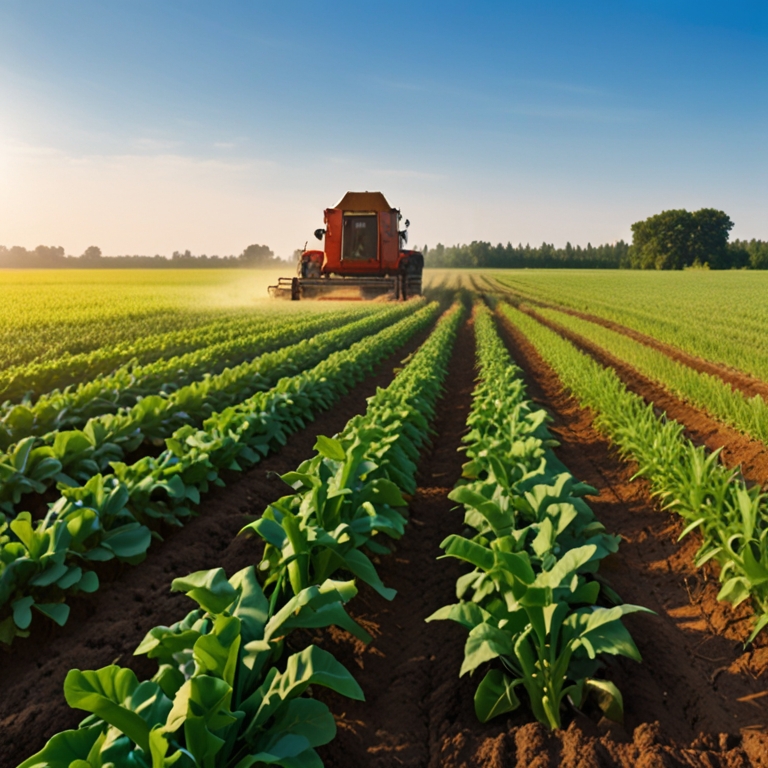
Why Developing Agriculture Matters
Agriculture supports over 2.5 billion people globally, particularly in rural areas, and accounts for a significant share of GDP in many countries. Developing agriculture enhances food security, creates jobs, and mitigates environmental impacts. By adopting modern agriculture techniques, societies can address challenges like climate change, soil degradation, and water scarcity. The importance of agriculture development lies in its ability to foster economic growth, improve nutrition, and build resilient communities.
This guide outlines evidence-based strategies to develop agriculture, from leveraging technology to empowering farmers and promoting sustainability.
1. Embrace Modern Technology and Innovation
Technology is revolutionizing agriculture, boosting efficiency and yields.
Precision Agriculture
Precision agriculture uses tools like GPS, drones, and sensors to monitor crops and soil conditions. These modern agriculture techniques optimize water, fertilizer, and pesticide use, reducing costs and environmental impact. For instance, soil sensors can detect nutrient levels, ensuring precise application.
How to Implement: Invest in affordable sensors or drones for small farms. Governments can subsidize technology access, while farmers can use apps like FarmLogs to analyze data and improve decision-making.
Biotechnology and Genetic Modification
Genetically modified (GM) crops, like drought-resistant maize, increase yields by up to 20% in some regions. Biotechnology also includes biofortified crops, enhancing nutritional value. Biotechnology in agriculture supports food security in challenging climates.
How to Implement: Partner with agricultural research institutions to develop and distribute GM seeds suited to local conditions. Educate farmers on safe use to address concerns about GMOs.
Automation and Robotics
Automated machinery, such as robotic harvesters or autonomous tractors, reduces labor costs and improves efficiency. Automation in agriculture is ideal for large-scale farms facing labor shortages.
How to Implement: Encourage investment in robotics through grants or loans. Small farms can adopt semi-automated tools, like mechanized planters, to boost productivity.
SEO Tip: Keywords like modern agriculture techniques and biotechnology in agriculture target readers seeking innovative solutions.
2. Promote Sustainable Farming Practices
Sustainability is key to long-term agricultural development, preserving resources for future generations.
Crop Rotation and Diversification
Rotating crops and diversifying plant varieties improve soil health and reduce pest risks. For example, alternating legumes with cereals restores nitrogen levels. Sustainable farming practices like these enhance yields and resilience.
How to Implement: Train farmers on crop rotation schedules. Agricultural extension services can provide guides on local crop combinations.
Organic Farming
Organic farming avoids synthetic chemicals, promoting biodiversity and soil fertility. It appeals to growing consumer demand for eco-friendly products. Organic farming for sustainability can also increase farm income through premium prices.
How to Implement: Offer certifications and training for organic farming. Support farmers with organic pest control methods, like neem oil or companion planting.
Water Conservation
Efficient irrigation systems, like drip irrigation, reduce water waste by up to 50%. Rainwater harvesting and watershed management further conserve resources. Water conservation in agriculture is critical in water-scarce regions.
How to Implement: Install drip irrigation systems with government or NGO support. Educate farmers on rainwater harvesting techniques, such as building small reservoirs.
3. Improve Access to Education and Training
Empowering farmers with knowledge enhances productivity and innovation.
Agricultural Extension Services
Extension programs provide training on modern techniques, pest management, and market trends. Farmer education programs bridge the gap between research and practice, boosting yields.
How to Implement: Governments or NGOs can fund extension services, deploying experts to rural areas. Mobile apps or radio programs can deliver training to remote farmers.
Vocational Training
Vocational programs teach skills like machinery maintenance or agribusiness management. Agricultural training for farmers prepares them for diverse roles, from farm management to marketing.
How to Implement: Establish local training centers or online courses through platforms like Coursera. Partner with universities for specialized programs.
Financial Literacy
Financial knowledge helps farmers manage costs, access credit, and invest in technology. Financial literacy in agriculture supports economic stability.
How to Implement: Offer workshops on budgeting and loan management. Apps like YNAB can help farmers track expenses.
4. Enhance Access to Resources
Access to quality inputs and financing is critical for improving agricultural productivity.
Quality Seeds and Fertilizers
High-yielding, climate-resilient seeds boost production, while balanced fertilizers improve soil health. Access to agricultural inputs ensures consistent harvests.
How to Implement: Subsidize seeds and fertilizers for smallholder farmers. Establish seed banks to distribute locally adapted varieties.
Affordable Financing
Loans or microfinance enable farmers to invest in equipment or land. Agricultural financing reduces financial barriers, particularly for small farms.
How to Implement: Partner with microfinance institutions or banks to offer low-interest loans. Governments can provide loan guarantees to encourage lending.
Land Access
Secure land tenure encourages investment in long-term improvements, like irrigation or soil conservation. Land access for farmers is vital for productivity.
How to Implement: Reform land policies to ensure equitable access, especially for women and young farmers. Community land trusts can support collective ownership.
5. Strengthen Infrastructure and Market Access
Robust infrastructure and markets connect farmers to consumers, enhancing profitability.
Rural Infrastructure
Improved roads, storage facilities, and irrigation systems reduce post-harvest losses, which can reach 30% in some regions. Agricultural infrastructure development ensures efficiency.
How to Implement: Invest in rural roads and cold storage units. Public-private partnerships can fund large-scale projects.
Market Linkages
Connecting farmers to markets increases income and reduces reliance on middlemen. Market access for farmers supports economic growth.
How to Implement: Develop farmer cooperatives to negotiate better prices. Online platforms like e-Choupal connect farmers directly to buyers.
Value-Added Products
Processing crops into products like jams or oils increases profitability. Value-added agriculture creates jobs and boosts local economies.
How to Implement: Provide training on food processing and packaging. Support small-scale processing units with grants or equipment.
6. Foster Community and Policy Support
Community engagement and supportive policies drive systemic change.
Farmer Cooperatives
Cooperatives pool resources, share knowledge, and improve bargaining power. Farmer cooperatives for development enhance resilience and income.
How to Implement: Encourage cooperative formation through government incentives. Provide training on cooperative management.
Policy Reforms
Policies like subsidies, crop insurance, or trade agreements support farmers. Agricultural policy reforms create a supportive environment.
How to Implement: Advocate for subsidies on sustainable inputs or insurance against climate risks. Engage farmers in policy discussions to ensure relevance.
Women and Youth Empowerment
Women and youth are often underrepresented in agriculture. Empowering them increases productivity and innovation. Empowering women in agriculture addresses gender gaps, while youth bring fresh perspectives.
How to Implement: Offer targeted training and financing for women and young farmers. Promote gender-inclusive policies and youth agricultural programs.
7. Address Climate Change and Environmental Challenges
Climate change threatens agriculture with droughts, floods, and pests. Adaptation is critical for sustainable agriculture development.
Climate-Smart Agriculture
Techniques like agroforestry or conservation tillage mitigate climate impacts. Climate-smart agriculture ensures resilience and sustainability.
How to Implement: Train farmers on climate-smart practices, such as planting cover crops. Provide access to climate-resilient seeds.
Soil Health Management
Healthy soil supports higher yields and sequesters carbon. Practices like composting or reduced tillage enhance soil health in agriculture.
How to Implement: Educate farmers on organic composting or no-till farming. Subsidize soil testing to monitor nutrient levels.
Renewable Energy
Solar-powered irrigation or biogas reduces costs and emissions. Renewable energy in agriculture supports sustainability.
How to Implement: Install solar pumps with government or NGO support. Promote biogas digesters for small farms.
8. Leverage Data and Research
Data-driven decisions enhance efficiency and innovation.
Agricultural Research
Research on crop varieties, pest control, or soil health drives progress. Agricultural research for development improves yields and sustainability.
How to Implement: Fund research institutions and share findings with farmers through extension services. Encourage farmer-led trials to test innovations.
Data Analytics
Weather forecasts, market trends, and crop monitoring data inform decisions. Data in agriculture optimizes resource use.
How to Implement: Provide farmers with access to weather apps or market price platforms. Train them to interpret data for better planning.
9. Encourage Agro-Tourism and Diversification
Diversifying income sources strengthens agricultural economies.
Agro-Tourism
Farm tours or pick-your-own experiences attract visitors, boosting income. Agro-tourism for farmers promotes local culture and products.
How to Implement: Develop farm-based tourism programs, like vineyard tours or farm stays. Market through platforms like Airbnb Experiences.
Diversified Income Streams
Raising livestock or growing specialty crops diversifies revenue. Agricultural diversification reduces risk from market or climate fluctuations.
How to Implement: Train farmers on livestock management or niche crops like herbs. Provide grants for diversifying farm activities.
Conclusion
Developing agriculture requires a multifaceted approach, combining technology, sustainability, education, and policy support. By embracing modern agriculture techniques, promoting sustainable farming practices, and empowering farmers with resources and knowledge, societies can ensure food security, economic growth, and environmental health. Start small—adopt one strategy, like drip irrigation or crop rotation—and scale up through community and government support. For further resources, explore organizations like the Food and Agriculture Organization (FAO) or local agricultural extension services. Investing in agriculture today builds a resilient, thriving future.

